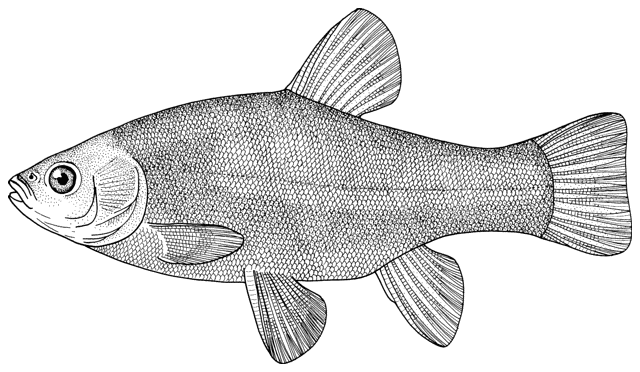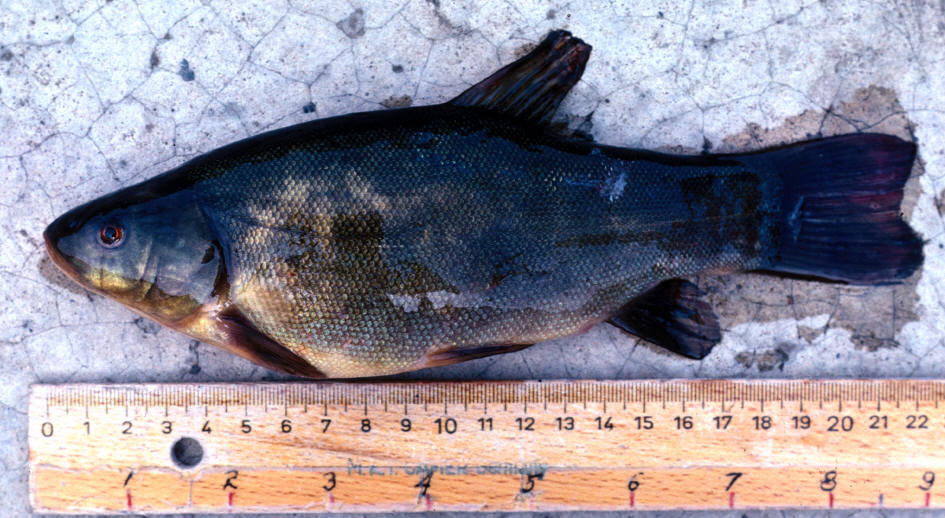
Species Accounts - Cyprinidae - Tinca
.Genus Tinca
Cuvier, 1816
The tench genus contains a single species found from Europe to Siberia including the Caspian Sea basin.
The characters of this genus include very small, elongate scales deeply embedded in slimy skin, pharyngeal teeth in a single row, all fins rounded and without spines, a short barbel at the terminal mouth corner, no keel on the belly, moderately long gill rakers, and short dorsal and anal fins.
Tinca tinca
(Linnaeus, 1758)


CMNFI 1979-0439, Gilan, Anzali Mordab
Common names
لاي ماهي (= lie, lai, lay or laay mahi, meaning bottom-dwelling or mud fish); nazi; tilkhos; saboni (= soapy?); hashtarkhan kapur.
[lil baligi in Azerbaijan; sew-zukgná in Armenia; lin' in Russian; tench, common tench, green tench].
Systematics
Cyprinus Tinca was described originally from European lakes. Ljabner et al. (2010) found the western and eastern phylogroups of tench were a single species under the biological species concept, although they were separate phylogenetic species. Tench from a western European and a Ponto-Caspian refugium came into contact by postglacial expansion after a separation of 750,000 years, and showed free interbreeding.
Key characters
The dark coloration, rounded fins and slimy body are characteristic of this species.
Morphology
Dorsal fin unbranched rays 2-4, usually 3-4 followed by 6-9, usually 8, branched rays, anal fin unbranched rays 3-4 and branched rays 5-9, usually 6-7, pectoral fin branched rays 13-18, and pelvic fin branched rays 7-10. Lateral line scales 70-120, gill rakers 10-16, usually 11-15, and vertebrae 35-44, usually 39-43. Anterior gill rakers may be difficult to distinguish from throat tubercles. Central rakers touch the one below when appresssed. Scales are very elongate ovals with a very anterior focus near the anterior scale margin. Radii are numerous on all fields. Pharyngeal teeth 4-5, 5-4, 5-3 or 4-4, more rarely 5-5, slightly to strongly hooked and expanded at the tip into a head supported on a narrow stalk. The oblique head has rounded edges and is concave in the middle. The gut is s-shaped with a small anterior loop. The chromosome number is 2n=48 (Klinkhardt et al., 1995).
Meristic values for Iranian specimens are:- dorsal fin branched rays 8(28); anal fin branched rays 5(1), 6(11), 7(15) or 8(1); pectoral fin branched rays 15(10), 16(13) or 17(5); pelvic fin branched rays 9(27) or 10(1); lateral line scales very embedded and obscured by skin and mucus, range about 82-95; total gill rakers 11(4), 12(7), 13(8), 14(7) or 15(2); pharyngeal teeth 5-4(5), 4-5(2) or 4-4(1); and total vertebrae 37(1), 38(7), 39(14) or 40(1).
Sexual dimorphism
The second pelvic fin ray in males is thickened and is accompanied by a muscular protuberance from the flank. Pelvic fins reach the anal fin in males.
Colour
The overall colour is a blackish-green, green or dark brown to bronze. Colour varies with habitat and is lighter in areas with less vegetation. The iris is red and the lips are yellowish-orange. Fins are grey to greenish or blackish. Golden, red and orange forms, some with black spots, may be bred in garden ponds and aquaria. Preserved fish have a dark body and fins with a lighter belly.
Size
Reaches 84.0 cm total length and about 8.5kg, possibly 10.0 kg.
Distribution
Found from the British Isles and the Iberian Peninsula across Europe to Siberia including southern drainages of the Black and Caspian seas. In Iran it is reported from the Anzali Mordab and neighbouring rivers to the Gorgan River (Holčík and Oláh, 1992; Riazi, 1996; Abbasi et al., 1999; Kiabi et al., 1999; Abdoli, 2000; Daghigh Roohi and Mokhayer, no date). Khara et al. (2005) record it from the Amirkelayeh Wetland near Lahijan.
Zoogeography
This widespread species has no close relatives among Eurasian cyprinids.
Habitat
Tench inhabit bays, small and shallow lakes, slow rivers and estuarine areas rich in vegetation. They are confined to the lower reaches of rivers in Iran and do not penetrate upstream (Berg, 1948-1949). Riazi (1996) reports that this species is native (resident) to the Siah-Keshim Protected Region of the Anzali Mordab. They are essentially inactive in winter. Tench are reported to bury themselves in mud during severe winters, lying dormant until spring. They can tolerate weak brackish water (to 12‰), acidic waters, low oxygen conditions and temperatures as high as 37°C for short periods. Preferred temperatures are 15-23.5°C (Brylińska, Bryliński and Bănărescu in Bănărescu, 1999). They remain alive for long periods when removed from the water. In Iran, adults have been caught in gill nets at 1-2 m (Annual Bulletin 1993-94, Iranian Fisheries Research and Training Organization, Tehran, p. 78-79, 1995).
Age and growth
Anonymous (2006) studied of tench in the Amirkelayeh Lagoon and found age groups 1+ to 7+ years. Vetlugina (1992) studied the biology of tench in the Volga Delta using sections of dorsal fin rays for aging. Life span is 13 years or more. Females grow faster than males and comprise 90-100% of older fish. Growth rate is similar to fish from Dagestan, nearer Iranian waters. Tench begin to mature at 3 years (30-40% of fish are sexually mature) and by age 4-5, 60% are mature. In Dagestan they mature at 3-4 years (Shikhshabekov, 1977). Life span is up to 30 years elsewhere. Turkish populations in lakes formed by dams range up to 5 or 6 years of age (Altindağ et al., 1998; 2002). These authors give age-length and age-weight relationships and condition factors.
Food
Diet comprises insect larvae, crustaceans, small molluscs, aquatic worms, vegetation and detritus. Chironomids may constitute as much as 91.8% of the diet in the second year of life while older fish favour snails and algae and macrophytes. This fish is probably a carnivore, switching to vegetation when animals are not available. Food may be picked out of vegetation or nosed out of mud as much as 13 cm deep using the snout (Brylińska, Bryliński and Bănărescu in Bănărescu, 1999). Anonymous (2006) studied the diet of tench in the Amirkelayeh Lagoon and found 17 food groups including Odonata, snails, water plants, Trichoptera, Chironomidae, Hemiptera, Ephemeroptera, Perca fluviatilis, Diptera, Gammarus, Tubifex, plant seeds, Simulium, water bugs, water ticks, zooplankton and phytoplankton. Phytoplankton, snails and Hemiptera had the highest frequenceis at 68.5%, 65.7% and 34.0% respectively. This fish is an omnivore and diet varied with season age and sex.
Reproduction
Spawning occurs in shallow water with little current and abundant vegetation. Spawning aggregations can be seen in April in the Volga Delta and spawning takes place in May and June (Vetlugina, 1992). Tench in the Anzali Mordab have well-developed, 1.0 mm eggs in early June. Water temperatures at peak spawning are 20-26°C. In Dagestan, spawning takes place in June-July at water temperatures no lower than 19-20°C (Shikhshabekov, 1977). Each female is accompanied by 2-3 males and different males will fertilise the egg batches as they are released. Tench spawn 2 or 3 times at intervals of about 20-30 days, shedding eggs onto surface vegetation. Eggs are greenish, adhesive and up to 1.57 mm in diameter. Fecundity is up to 863,000 eggs (or 124,850 per kg of body weight) and increases with age, length and weight. Larvae have attachment organs which enable them to hang onto plants for the first few days of life. Maximum fecundity is 1,241,200 eggs in eastern Europe.
Parasites and predators
Daghigh Roohi and Mokhayer (no date) record the trematode Asymphylodora tincae from this fish in the Anzali Lagoon, the first record of this parasite in Iran. Khara et al. (2005) found parasites of this species in the Amirkelayeh Wetland were Raphidascaris acus, Camallanus lacustris, Asymphylodora tincae, Diplostomum spathaceum, Dactylogyrus sp., Caryophyllaeus fimbriceps, Lernaea sp. and Trichodina sp. Khara et al. (2006a) record the eye fluke Diplostomum spathaceum for this fish in the Amirkelayeh Wetland in Gilan, although it had the lowest abundance of 7 species examined. Sattari et al. (2004, 2005) surveyed this species in the Anzali and Amirkelayeh wetlands, recording Raphidascaris acus larvae and Camallanus lacustris. Khara et al. (2006b) record the trematode Asymphylodora tincae from this species in the Boojagh Wetland of the Caspian coast.
Economic importance
Commercial catches are made in the Volga Delta where there are spring (April) and fall (September-October) fishing seasons. Up to 6,300 tonnes are taken using fyke nets, trap nets and seines. Holčík and Oláh (1992) report a catch of 540 kg in the Anzali Mordab in 1990.
The tench is a sought-after sport fish in Europe, putting on a strong fight for its weight (personal experience). There is an ornamental form, orange-yellow or reddish, which is kept in park ponds.
The roe or eggs of this species are particularly poisonous and it should be cleaned with care to avoid contamination of the flesh although it is not a common market fish in Iran (Halstead, 1967-1970; Coad, 1979b). Probable symptoms and treatment are given under the genus Schizothorax.
The tench is reputedly a "doctor fish" and other species are said to rub against its slimy body as a cure for injuries. Rubbed on humans, it is said to cure fever, headache, toothache and jaundice. In Iran, this species has been proposed as a component of polyculture as it feeds on snails, a host for diplostomiasis-causing parasites. A decrease in snail frequency varied from 43 to 82% in experiments using adult and juvenile tench (Iranian Fisheries Research Organization Newsletter, 37:3, 2003).
Robins et al. (1991) list this species as important to North Americans. Importance is based on its use as food, in textbooks and because it has been introduced outside its natural range.
Conservation
Lelek (1987) classifies this species as intermediate in Europe (liable to be transferred to vulnerable or rare categories if their habitat deteriorates further). Kiabi et al. (1999) consider this species to be of least concern in the south Caspian Sea basin according to IUCN criteria. Criteria include commercial fishing, sport fishing, abundant in numbers, habitat destruction, widespread range (75% of water bodies), absent in other water bodies in Iran, and present outside the Caspian Sea basin.
There have been attempts to breed this species artificially in Iran to increase the recruitment rate and control loss (Annual Bulletin 1993-94, Iranian Fisheries Research and Training Organization, Tehran, p. 78-79, 1995; Annual Report, 1994-1995, Iranian Fisheries Research and Training Organization, Tehran, p. 39, 1996; Sirang, 1997). Brood fish weighed 0.2-0.45 kg and were kept in earthen ponds. Carp culture techniques were used with injection of gonadotropic hormones from carp pituitary at 3-8 mg per kg body weight applied in two doses. Water temperatures were 20-24°C, eggs were placed in saline carbamide solution after fertilisation to remove stickiness and washed in pure water. Swelled eggs measured 0.65-0.8 mm and were bright yellow to greenish-yellow. The number of eggs per spawner was 10,848-17,710 and 80-350 eggs per 1 g body weight. Fertilisation rate was 70-85%. Eggs were incubated for 2.0-2.5 days with a survival rate of hatched fry at 85-95% and size of newly hatched larvae at 4.5-5.0 mm.
Further work
The biology of this species has been well-studied elsewhere in its extensive range but not under Iranian conditions.
Sources
Iranian material: CMNFI 1970-0514, 2, 63.9-106.9 mm standard length, Gilan, Shafa River estuary (37º35'N, 49º09'E); CMNFI 1970-0553, 1, 70.9 mm standard length, Gilan, Sowsar Roga River (37º27'N, 49º30'E); CMNFI 1970-0580, 3, 28.0-36.2 mm standard length, Mazandaran, river near Iz Deh (36º36'N, 52º07'E); CMNFI 1979-0439, 1, 170.9 mm standard length, Gilan, Anzali Mordab (ca. 3727'N, ca. 4925'E); CMNFI 1980-0148, 14, 33.9-49.7 mm standard length, Gilan, Pir Bazar Roga River (37º21'N, 49º33'E); CMNFI 1980-0916, 6, 38.2-51.1 mm standard length, Gilan, Nahang Roga River (no other locality data); CMNFI 1993-0137, 1, 150.4 mm standard length, Mazandaran, Sari (36º34'N, 53º04'E).
© Brian W. Coad (www.briancoad.com)